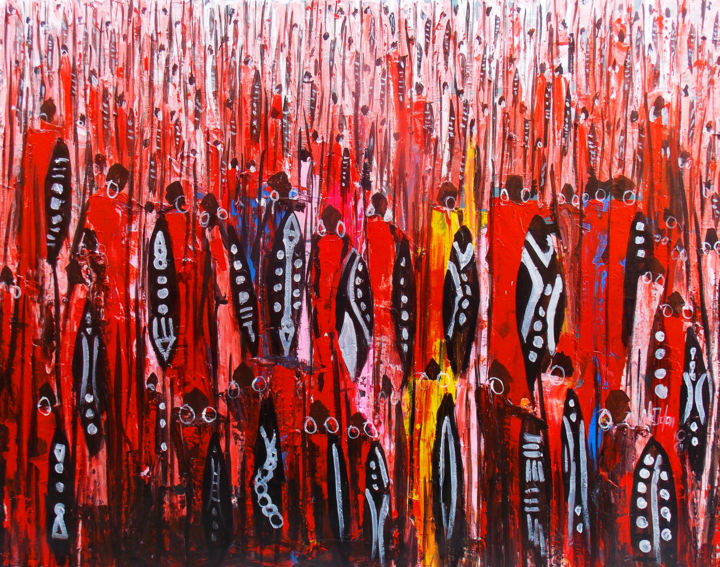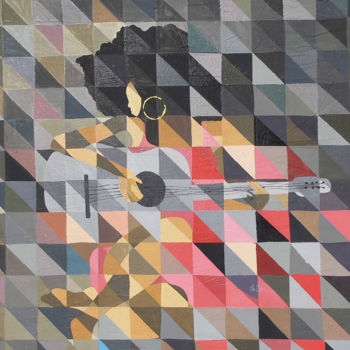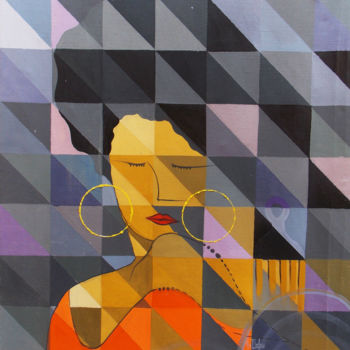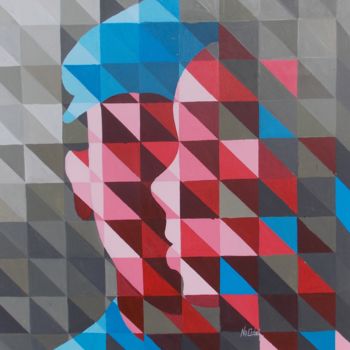Massai Warriors (2019) Painting by Theophilus Tetteh
Sold
Sold by Theophilus Tetteh
-
Original Artwork
Painting,
Acrylic
on Canvas
- Dimensions Height 40in, Width 50in
- Categories Paintings under $1,000 Abstract
The Masai Tribe ~ (also spelt Maasai) are part of a larger grouping of Nilotic speaking tribes & live in southern Kenya & northern Tanzania. Junior Elders are careful to show respect to their Senior Elders. All important decisions affecting the community are taken by the Senior Elders in their council of elders, the “Enkiguena”. Status is based on the wisdom of the elder & not on wealth. The Masai believe in one God “Enkai” & they pray to him daily for rain & prosperity. For spiritual guidance they revere the “Laibon” who are the traditional healers of the tribe.
Traditional Dress ~ the red plaid fabric draped over their shoulders is called a “shuka”. Both men & woman wear beaded decorations & sport enlarged earlobes. Only married women are allowed to wear ear ornaments in their lobes. Before marriage, a single girl may decorate only the upper ear which is pierced with a large hole & beading fastened to the ear. A narrow decorated leather belt supports the hide scabbard of the short sword carried by the “Moran” (warrior).
The Homestead ~ a traditional Masai homestead within the circular “enkang” settlement, guarded by a thorn branch hedge. Masai women construct the low dwelling around the perimeter of the settlement, allowing space in the centre for cattle to be penned at night. Cattle ownership takes centre stage & each animal in the cattle herd is known individually & nurtured accordingly. At times, young animals are housed within the dwellings at night to protect them from the cold. A household head of moderate wealth will own a herd of 50 cattle & a favourite bull may be decorated with elaborate markings. A Masai elder may have several wives. His first wife constructs a dwelling to the right of the entrance of the enkang, the second wife to the left. Apart from being responsible for building & maintaining the dwellings, Masai women milk the cows & gather firewood.
Ceremony & Ritual ~ the passage from one “age-set” to the next is very important & is marked by several days of ceremony & ritual. In Masai society circumcision is a ritual that signifies the passing of childhood & establishes the first age-set, usually at 12 years of age. Once boys have been circumcised, they graduate to the esteemed ranks of the “Moran” - new recruits to the rank of warrior. The ceremony is planned two months in advance whilst the women build houses in the “manyatta” - a settlement built to accommodate the Moran & their attendants. At dusk on the evening before the circumcision ceremony mothers shave their son’s heads & at dawn the next morning they are numbed with cold river water & circumcised. Circumcision is performed without any anaesthetic & if a boy flinches he will not be allowed to graduate to warrior. An ox is slaughtered & blood is ceremoniously extracted from its neck, mixed with milk or honey beer, & given to the circumcised boy to drink. The young “Morani” grows his hair, regularly applies red ochre & devotes much time to plaiting it, & adorning it with beads & medallions. Ear lobes are adorned with colourful beads & a special neckband is worn. After some time, the junior warriors (Morani) join the senior warriors (Moran) to form a single unit in the “manyatta” & return from the bush to receive a jubilant welcome. Warriors, according to traditional law, may never eat alone & are always found together in groups. At close of day, the Moran often dance the “adumu” jumping dance of the Masai. The dance, as well as the songs that accompany it, recall legendary cattle raids, battles, & the deeds of brave men.
Eunoto Ceremony ~ a weeklong ceremony marking graduation from Senior Moran to Junior Elder after approximately 7 years. In full regalia, the warriors gather in the hills & begin their procession to the manyatta, the Moran at the head of the procession blows a wind instrument, made from the horn of a greater kudu, alerting everyone to the “Eunoto”. After the Eunoto they have their heads shaved by their mothers & smeared with red ochre, the men then gather together to sing & dance. During the ceremony, several oxen are slaughtered & ceremonial feasting takes place. Masai men take part in the “adumu” dance by forming a circle & singing deep rhythmic songs, one or two of the men dance in the centre of the circle, leaping up & down, their bodies held rigid & their faces set in fierce concentration. After the ceremony the Junior Elders are allowed to marry & gifts are taken to a prospective bride’s parents. On the day of the wedding, the bride’s family put on their finest necklaces & paint their faces with red ochre. The young bride is dressed in the softest skins & finest jewellery by her mother, & as she leaves the enkang the bride is blessed by her father. Expressing great sorrow, the bride leaves the familiar comforts of her enkang behind. The young bride is escorted by the groom & his best man to her new home where she is welcomed by the women. The bride then enters her future mother-in-law’s dwelling & remains there until the wedding.
Beadwork ~ is an important part of Masai culture & Masai women set aside time every day to meet & work on beaded jewellery. The jewellery they create is not only beautiful but also has important cultural significance. The beadwork an individual wears will signify their age & social status. Generally individuals of high social standing will wear more colourful and intricate jewellery. The most popular necklace worn by Masai women is a large flat disc that surrounds the neck, which is made up of rows of beads threaded onto wire, secured & spaced with cowhide strips. The colours used in the beadwork are not only selected for their beauty, they are also symbolic & have important meanings understood by the tribe. Often these meanings have an association with cattle, for which they have a deep connection. Below is a list of the main colours used in Masai beadwork & the meanings associated with each:
• Red ~ stands for bravery, unity, & blood. Red is the colour of cow’s blood & cow’s blood is always symbolic in Masai ceremonial rituals.
• Blue ~ represents God & the heavens. Rain falls from the blue sky which provides water for the cattle.
• Yellow ~ like orange yellow also symbolizes hospitality. The animal skins on visitor’s beds are yellow.
• White ~ represents peace, purity, & health. The association with health comes from white cow’s milk which the tribe drinks to stay healthy.
• Black ~ represents the people & the struggles they must endure.
Related themes
Theophilus Tetteh is my name.I am an artist in my stage of artistic experimentation and expression . I am fascinated by the verities abundant in nature, not losing sight of the inspiration that the man-made world has to offer. He was trained at Marimus Art School, where he specialized in painting and Graphic Designing. He study in such an environment has made him versatile in his choice of media, technique and subject matter. Analytical Cubism is how he describes his technique concentrating or breaking down visual forms.on many occasion he depicts the physical environment ( human dwelling, trees etc.) in a stylish and colorful way. He hope that through his artistic expression, viewers will be inspired to take a second look at their environment in a different way. Less
-
Nationality:
GHANA

- Date of birth : 1991
- Artistic domains:
- Groups: Ghanaian Contemporary Artists







